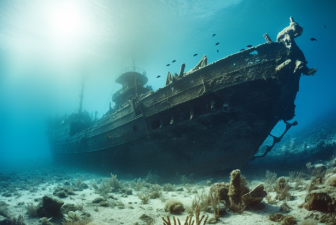Students who love ancient civilizations should know that the earliest human civilization is believed to have originated from the Sumerians in the Mesopotamian Basin. The Sumerian civilization, which invented cuneiform, is about 8,000 years old. After more than 3,000 years, it was replaced by the Babylonian civilization. However, at the end of the last century, an underwater relic discovered near the Ryukyu Islands in Japan is likely to completely subvert the cognition of human civilization.
Students who love ancient civilizations should know that the earliest human civilization is believed to have originated from the Sumerians in the Mesopotamian Basin. The Sumerian civilization, which invented cuneiform, is about 8,000 years old. After more than 3,000 years, it was replaced by the Babylonian civilization. However, at the end of the last century, an underwater relic discovered near the Ryukyu Islands in Japan is likely to completely subvert the cognition of human civilization. What secrets are hidden in this suspicious deep-sea relic? In the southernmost part of Japan, further south than Okinawa Island, there is a small island called Yonaguni. The island is located at the westernmost end of the Yaeyama Islands in the Ryukyu Islands. From the map, it is on the edge of the continental shelf, only one step away from Taiwan Island. Yonaguni Island has an area of about 28.88 square kilometers, a coastline of about 28 kilometers, a population of about 1,745, and an average annual temperature of 23.9℃. Due to the strong southerly wind blowing on the island all year round, the erosion of the southern coast is more obvious, and most of them are cliffs. Nishizaki in the west is the westernmost cape of Japan, and there is a monument that reads "Japan - the westernmost place - Yonaguni Island".

Because Yonaguni Island is too small and does not have very attractive scenery, it has never been a tourist attraction. But because there are a large number of hammerhead sharks living in the nearby waters, diving enthusiasts often visit here.
One day in 1987, a diver named Shinsou Kihachiro accidentally discovered a shocking secret while diving here: he found that there was a majestic and huge rock formation on the seabed near the island, and this rock formation showed a pyramid-like architectural structure.
Later, the University of the Ryukyu established the "Undersea Archaeological Survey Team", with Masaaki Kimura (Mainly studying plate movement and earthquakes), a professor of marine geology at the school, as the core, and began a 15-year investigation of this landform.
During the investigation, they found that this rock formation contained a huge polygonal platform, which was covered with thick corals because of its age. On the platform, buildings such as streets, stairs and arches were also found. The entire building is about 200 meters long from east to west, about 140 meters wide from north to south, and about 26 meters at its highest point.
From the appearance, it can't help but remind people of the remains of altars and temples of ancient civilizations.
In subsequent investigations, various stone buildings, column holes, human head statues, arches, and even a sculpture similar to a turtle composed of geometric figures were discovered on the seabed of the southeast coast of Ishigaki Island.
Archaeologists even found something similar to "hieroglyphs" on the stone walls of the ruins. This can't help but make people guess that it is a fairly developed ancient human civilization site.
The entire underwater building faces north and south, and the specific coordinates are (24°26'58" north latitude, 122°56'1" east longitude). The "stairs" of the building start from its front and lead to two areas: to the east to the "sacrificial area" and to the west to the "step area". (Of course, these areas are not officially named, but only tentatively speculated.) The latter is characterized by its rock sections being perpendicular to each other and perfectly cut at right angles.
On the highest level of the main building of the underwater ruins, there are three cylindrical holes for large stone pillars, which may have collapsed; there is also a trap door leading to a room on the lower level, where a tombstone archway is placed. Another structure called the "Goshintai" contains a stone of a special shape, and studies have shown that it may have functioned as an ancient sundial.
